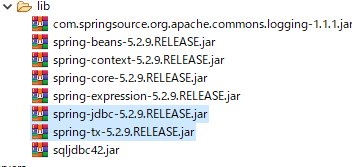一、JDBC模板使用入门
①、创建项目,引入jar包
-
- 引入基本开发包
- spring-beans-5.2.9.RELEASE.jar
- spring-context-5.2.9.RELEASE.jar
- spring-core-5.2.9.RELEASE.jar
- spring-expression-5.2.9.RELEASE.jar
- com.springsource.org.apache.commons.logging-1.1.1.jar
- 数据库驱动
- sqljdbc42.jar
- Spring的JDBC模板的jar包
- spring-jdbc-5.2.9.RELEASE.jar
- spring-tx-5.2.9.RELEASE.jar
- 引入基本开发包

②、创建数据库和表
create database [HibernateDB] USE [HibernateDB] CREATE TABLE [dbo].[account]( [id] [int] IDENTITY(1,1) NOT NULL, [name] [varchar](50) NULL, [money] [decimal](18, 2) NULL, CONSTRAINT [PK_account] PRIMARY KEY CLUSTERED ( [id] ASC )WITH (PAD_INDEX = OFF, STATISTICS_NORECOMPUTE = OFF, IGNORE_DUP_KEY = OFF, ALLOW_ROW_LOCKS = ON,
ALLOW_PAGE_LOCKS = ON) ON [PRIMARY] ) ON [PRIMARY] GO
③、使用JDBC的模板:保存数据
public class JdbcDemo { @Test public void demo1() { //创建连接池 DriverManagerDataSource dataSource=new DriverManagerDataSource(); dataSource.setDriverClassName("com.microsoft.sqlserver.jdbc.SQLServerDriver"); dataSource.setUrl("jdbc:sqlserver://localhost:1433;databaseName=HibernateDB;"); dataSource.setUsername("sa"); dataSource.setPassword("AAA@111"); //创建jdbc模板 JdbcTemplate jdbcTemplate=new JdbcTemplate(dataSource); jdbcTemplate.update("insert into account values(?,?)","zhangsan",1000000.00); } }
④、将连接池和JDBC模板交给Spring管理
Ⅰ、引入spring-aop-5.x.jar
Ⅱ、新建Spring的配置文件
<beans xmlns="http://www.springframework.org/schema/beans" xmlns:xsi="http://www.w3.org/2001/XMLSchema-instance" xsi:schemaLocation=" http://www.springframework.org/schema/beans
https://www.springframework.org/schema/beans/spring-beans.xsd"> <bean id="dataSource" class="org.springframework.jdbc.datasource.DriverManagerDataSource"> <property name="driverClassName" value="com.microsoft.sqlserver.jdbc.SQLServerDriver"/> <property name="url" value="jdbc:sqlserver://localhost:1433;databaseName=HibernateDB;"/> <property name="username" value="sa"/> <property name="password" value="AAA@111"/> </bean> <bean id="jdbcTemplate" class="org.springframework.jdbc.core.JdbcTemplate"> <!-- 属性注入 jdbcTemplate实例化时,需要dataSource--> <property name="dataSource" ref="dataSource"></property> </bean> </beans>
Ⅲ、测试方法
//使用@SpringJUnitConfig此注解需要引入spring-test...jar包 @SpringJUnitConfig(locations = "classpath:applicationContext.xml") public class JdbcDemo { @Autowired private JdbcTemplate jdbcTemplate; @Test public void demo1() { jdbcTemplate.update("insert into account values(?,?)","zhangsan",1000000.00); } }
二、使用开源的数据库连接池
①、DBCP的使用
Ⅰ、引入jar包
com.springsource.org.apache.commons.dbcp-1.2.2.osgi.jar
com.springsource.org.apache.commons.logging-1.1.1.jar
Ⅱ、配置DBCP连接池
<bean id="dataSource" class="org.apache.commons.dbcp.BasicDataSource"> <property name="driverClassName" value="com.microsoft.sqlserver.jdbc.SQLServerDriver"/> <property name="url" value="jdbc:sqlserver://localhost:1433;databaseName=HibernateDB;"/> <property name="username" value="sa"/> <property name="password" value="AAA@111"/> </bean> <bean id="jdbcTemplate" class="org.springframework.jdbc.core.JdbcTemplate"> <!-- 属性注入 jdbcTemplate实例化时,需要dataSource--> <property name="dataSource" ref="dataSource"></property> </bean>
②、C3P0的使用
Ⅰ、引入c3p0连接池jar包
com.springsource.com.mchange.v2.c3p0-0.9.1.2.jar
Ⅱ、配置c3p0连接池
<bean id="dataSource" class="com.mchange.v2.c3p0.ComboPooledDataSource"> <property name="driverClass" value="com.microsoft.sqlserver.jdbc.SQLServerDriver"/> <property name="jdbcUrl" value="jdbc:sqlserver://localhost:1433;databaseName=HibernateDB;"/> <property name="user" value="sa"/> <property name="password" value="AAA@111"/> </bean> <bean id="jdbcTemplate" class="org.springframework.jdbc.core.JdbcTemplate"> <!-- 属性注入 jdbcTemplate实例化时,需要dataSource--> <property name="dataSource" ref="dataSource"></property> </bean>
三、抽取配置到属性文件(.properties)
①、定义一个属性文件(jdbc.properties)
jdbc.driverClass=com.microsoft.sqlserver.jdbc.SQLServerDriver jdbc.url=jdbc:sqlserver://localhost:1433;databaseName=HibernateDB; jdbc.username=sa jdbc.password=AAA@111
②、在Spring的配置文件中引入属性文件
Ⅰ、通过一个bean标签引入(很少)
<bean class="org.springframework.beans.factory.config.PropertyPlaceholderConfigurer"> <property name="location" value="classpath:jdbc.properties"/> </bean>
Ⅱ、通过context标签引入
<context:property-placeholder location="classpath:jdbc.properties"/>
③、引入属性文件的值
<bean id="dataSource" class="com.mchange.v2.c3p0.ComboPooledDataSource"> <property name="driverClass" value="${jdbc.driverClass}"/> <property name="jdbcUrl" value="${jdbc.url}"/> <property name="user" value="${jdbc.username}"/> <property name="password" value="${jdbc.password}"/> </bean>
四、使用JDBC的模板完成CRUD的操作
①、插入
@SpringJUnitConfig(locations = "classpath:applicationContext.xml") public class JdbcDemo { @Autowired private JdbcTemplate jdbcTemplate; @Test public void demo1() { jdbcTemplate.update("insert into account values(?,?)", "zhangsan", 1000000.00); } }
②、更新
@Test public void demo2() { jdbcTemplate.update("update account set name=?,money=? where id =?", "lisi", 2000000.00, 2); }
③、删除
@Test public void demo3() { jdbcTemplate.update("delete from account where id=?", 3); }
以上[.update()]方法就可以了
④、查询
Ⅰ、查询某个属性(单个值)
@Test public void demo4() { String name = jdbcTemplate.queryForObject("select name from account where id=?", String.class, 4); System.out.println(name); } @Test public void demo5() { Long count = jdbcTemplate.queryForObject("select count(*) from account ", Long.class); System.out.println(count); }
Ⅱ、查询某个属性集合
@Test public void demo8() { List<Integer> list = jdbcTemplate.queryForList("select id from account ",Integer.class); for (Integer id : list) { System.out.println(id); } }
注意queryForList(sql,elementType)中的elementType:不支持自定义bean,这个class也只是支持Integer,String这些基本类型
Ⅲ、查询返回对象或集合
@Test public void demo6() { Account account = jdbcTemplate.queryForObject("select * from account where id=?", new MyRowMapper(), 4); System.out.println(account); } @Test public void demo7() { List<Account> list = jdbcTemplate.query("select * from account ",new MyRowMapper()); for (Account account : list) { System.out.println(account); } } class MyRowMapper implements RowMapper<Account> { @Override public Account mapRow(ResultSet rs, int rowNum) throws SQLException { Account account = new Account(); account.setId(rs.getInt("id")); account.setName(rs.getString("name")); account.setMoney(rs.getBigDecimal("money")); return account; } }